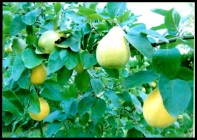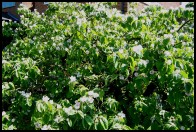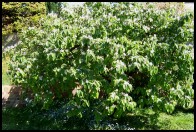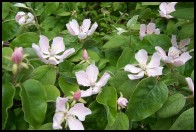| |
 
THE HUMBLE
QUINCE
 |
|
A few weeks ago,
my next-door neighbour, returning from a
holiday in France, presented me with a
pot of jam, curiously labelled simply
Coings. My limited French was not up to
translating this, but she soon told me
that it was Quince. Now she must know me
quite well, because quince jam is
something I’ll die for. Not jelly,
which you can find on the shelves at
Waitrose, but jam, occasionally made by
Tiptree, and apparently only stocked at
high class provision shops or
delicatessens.
An elderly friend of mine in Norfolk, who
makes all her own preserves, once told me
that in her long experience men always
prefer quince jam to jelly. It is
something about its texture, its
crunchiness perhaps. Anyway, put a jar of
quince jam and a loaf of fresh bread in
front of me and I’m like a dog with
two tails! |
Quinces originated in the
mountainous area between the Black Sea and the
Caspian Sea, known as the Caucasus, and quince
preserves are readily available in Middle Eastern
markets. Cultivation began in Persia, and was
favoured by the ancient Greeks, and it has been
suggested that all biblical references to apples
may, in fact, have been quinces.
Was the fruit of
Eve’s temptation then a quince? And
in the world of mythology was the golden
apple that the goddess Aphrodite gave to
Paris, leading ultimately to the Trojan
War, really a quince? Now there’s a
thought!
The quince is first mentioned in English
literature in the 13th century, and by
Tudor times must have been common enough
to be immortalised as Peter Quince in
Shakespeare’s A Midsummer
Night’s Dream. At that time quince
marmalade was apparently a popular
delicacy. The fruits were peeled and
quartered and boiled in red wine, then
strained and boiled again with honey and
spices. After cooling and setting, they
were sliced into pieces and served as a
dessert. Yum! |
 |
|
 |
|
In Victorian times
every garden had a quince tree, and the
wonderful aroma given off by the ripe
fruits often acted as an air freshener in
the drawing room of large houses. But,
alas, during the last century it fell
from grace as the popularity of soft
fruit grew. What
was there to do with those apparently
useless, rock hard fruits? However, I
don’t expect I’ll be the only
one making quince jam in the autumn,
though the thought of what peeling and
coring the rock hard fruit does to
one’s hands is frightening.
|
But the quince - the true
variety, not the ornamental climbing version - is
a beautiful tree. It doesn’t grow too big,
and other than periodical thinning out, requires
little maintenance. It comes into leaf early, and
is always smothered in large pink blossoms,
resembling wild roses. This year looks a good for
quinces, the warm spring bringing out insects
early to assist pollination. The pear shaped
fruit is slow to ripen and covered in fur until
it turns a beautiful golden yellow in October.
And by way of a bonus the leaves turn gold before
they fall.
There used to be
an old quince tree in the garden of
Winton House, but it has gone, and a
young specimen in the Physic Garden
succumbed to honey fungus last year.
Besides my own, the only one I know in
Petersfield now is on the side of a
garage in Windsor Road, but surely there
must be more.
Let’s hear it again for the humble
quince!
Tom Muckley, June 2007 |
|
 |
This article was originally
published by the
Petersfield Post
tommuckley.co.uk
|
|





